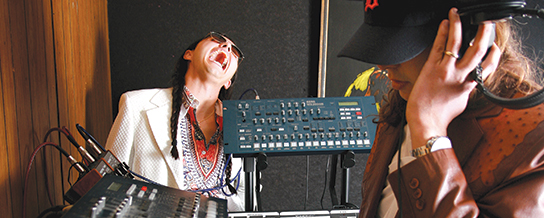Ghostland Observatory: Indie-Dance
Despite its reputation as a hotbed of live music, Austin, Texas still loves its daily […]

Ghostland Observatory: Indie-Dance
Despite its reputation as a hotbed of live music, Austin, Texas still loves its daily […]

Despite its reputation as a hotbed of live music, Austin, Texas still loves its daily dose of mid-’90s dance crack–at least according to Ghostland Observatory frontman Aaron Behrens. “Everybody loves Jammin’ 105.9!” he crows, citing his favorite local radio station and most recent source of artistic inspiration. “C+C Music Factory, Marky Mark… ’90s, like, sweat dance. It’s the shit! If you listen to the 20-minute block, you’ll hear some Bobby Brown.” His bandmate, drummer/knob-twiddler/keyboard wizard Thomas Turner, prefers slightly more obscure material: “I’ve been listening to this oldies station a lot: Gerry Rafferty, a lot of old jams. I listen to what my son likes–he’s two. He’s listening to Kraftwerk pretty hard right now.”
Ghostland Observatory formed nearly four years ago when Turner and Behrens met each other as members of Waking Helix, a more rock-oriented band. Discovering a mutual attraction to the world of synthesizers and samplers, the two split off and Turner, formerly a rave organizer, founded Trashy Moped Records to promote and release Ghostland’s records. Their debut, delete.delete.i.eat.meat, hit the streets in 2005. Behrens and Turner are currently holed up in their Austin rehearsal space, preparing for a spring tour to support their third record, Robotique Majestique, also on Trashy Moped.
Ghostland’s repertoire has always defied easy genre classification, with songs jumping from funk to rock to electro-disco, and RobotiqueMajestique is no exception. Even Turner seems hesitant to categorize his work. “We just make music that we like. We try to stay different–we never really tried to figure out what genre it is, we just do what we do,” he offers, his shrug on the other end of the line almost audible.
After Robotique’s psychedelic, grandiose “Opening Credits,” the album dives into a series of driving dance numbers, anchored by funky synth hooks, disco-inspired keyboard machinations, occasional IDM clicks and snaps (possibly a nod to Turner’s rave-happy past), and references to Daft Punk and Behrens’ beloved C + C Music Factory. The wave of dance numbers meets an abrupt end with “HFM,” a lo-fi dance-punk shout-fest that would easily find a place among stacks of Atari Teenage Riot and Add N to (X) records. The only common element, it seems, is Behren’s distinctive wail, which veers from Axl Rose-style falsetto to manly power-rock grunt.
Sonically, Robotique packs an exponentially stronger punch than the group’s previous work, a development indicative of their musical growth as well as a new focus on production techniques. “The first record was done in a duplex,” Turner recalls. “The second was done in an office space, and the third record was done in a barn. We definitely spent more time on production. We’ve been doing low-budget for such a long time, this was the fist time we got a proper mastering job.” It’s a big step up from Turner’s beer-truck-driving gig and Behrens’ mailroom job, but the band remains grounded. “We are civilians!” declares Turner.“Not full-time rock stars.”

